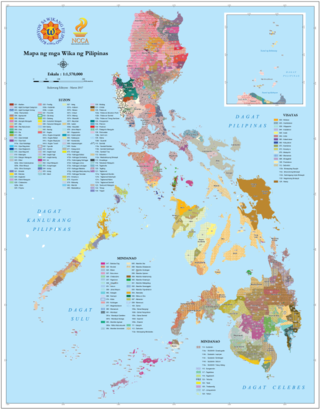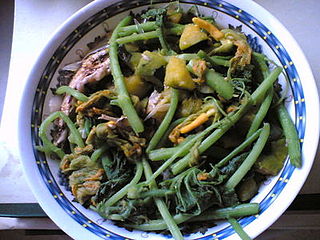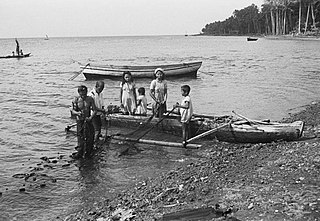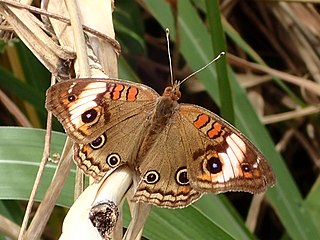
Filipino is a language under the Austronesian language family. It is the national language of the Philippines, lingua franca, and one of the two official languages of the country, with English. It is a standardized variety of Tagalog based on the native language, spoken and written in Metro Manila, the National Capital Region, and in other urban centers of the archipelago. The 1987 Constitution mandates that Filipino be further enriched and developed by the other languages of the Philippines.

There are some 130 to 195 languages spoken in the Philippines, depending on the method of classification. Almost all are Malayo-Polynesian languages native to the archipelago. A number of Spanish-influenced creole varieties generally called Chavacano along with some local varieties of Chinese are also spoken in certain communities. The 1987 constitution designates Filipino, a standardized version of Tagalog, as the national language and an official language along with English. Filipino is regulated by Commission on the Filipino Language and serves as a lingua franca used by Filipinos of various ethnolinguistic backgrounds.

Filipinos are citizens or people identified with the country of the Philippines. The majority of Filipinos today are predominantly Catholic and come from various Austronesian peoples, all typically speaking Tagalog, English, or other Philippine languages. Despite formerly being subject to Spanish colonialism, only around 2–4% of Filipinos are fluent in Spanish. Currently, there are more than 185 ethnolinguistic groups in the Philippines each with its own language, identity, culture, tradition, and history.

Fukuiraptor was a medium-sized megaraptoran theropod dinosaur of the Early Cretaceous epoch that lived in what is now Japan. Fukuiraptor is known from the Kitadani Formation and possibly also the Sebayashi Formation.

Japanese jazz, also called Japazz, is jazz played by Japanese musicians or jazz connected to Japan or Japanese culture. According to some estimates, Japan has the largest proportion of jazz fans in the world.

The Ichijōdani Asakura Family Historic Ruins are historic ruins located in the Kidonouchi section of the city of Fukui, Fukui Prefecture, in the Hokuriku region of Japan. This area was controlled by the Asakura clan for 103 years during the Sengoku period. It is designated as Special Historic Site in 1971, and in June 2007 2,343 artifacts were designated as Important Cultural Property.

Dinengdeng is a dish of the Ilocano people of the Philippines, similar to pinakbet. It is classified as a bagoong soup-based dish. Unlike pinakbet, dinengdeng contains fewer vegetables more soup base.

Fukui is the capital city of Fukui Prefecture, Japan. As of 1 March 2024, the city had an estimated population of 255,332 in 107,553 households. Its total area is 536.41 square kilometres (207.11 sq mi)and its population density is about 476 persons per km2. Most of the population lives in a small central area; the city limits include rural plains, mountainous areas, and suburban sprawl along the Route 8 bypass.

The concept of a Malay race was originally proposed by the German physician Johann Friedrich Blumenbach (1752–1840), and classified as a brown race. Malay is a loose term used in the late 19th century and early 20th century to describe the Austronesian peoples.
Indian Filipinos are Filipinos of Indian descent who have historical connections with and have established themselves in what is now the Philippines. The term refers to Filipino citizens of either pure or mixed Indian descent currently residing in the country, the latter a result of intermarriages between the Indians and local populations.

The big-eared horseshoe bat is a bat species within the Rhinolophidae native to Asia.

The 1948 Fukui earthquake occurred in Fukui Prefecture, Japan. The magnitude 6.8 quake struck at 4:13:31 p.m.(JDT) on June 28, 1948. The quake's hypocenter was approximately 10 km north-northeast of Fukui, in the present-day neighborhood of Maruoka, Sakai City. The strongest shaking occurred in the city of Fukui, where it was recorded as 6 on the Japan Meteorological Agency seismic intensity scale.

Cavisomidae are a family of parasitic worms from the order Echinorhynchida.
Arta is a highly endangered Negrito language of the northern Philippines.

Northern Alta is a distinctive Aeta language of the mountains of the Sierra Madre in Aurora province, Northern Philippines. Linguist Lawrence Reid reports two different Alta languages, Northern and Southern Alta, which form one of the high nodes of the Northern Luzon languages, together with the South-Central Cordilleran subgroup. Although the Alta languages are genetically related, they have a low level of mutual intelligibility.

Sangir is a native people of the Sangir Islands in the northern chain of islands in Sulawesi and the southern part of Mindanao. The Sangirese people are fishermen and nutmeg growers in their home areas and also work as wage labourers in industrial crops enterprises in Bolaang Mongondow Regency and Minahasa Regency.

Terelabrus is a genus of fish in the family Labridae found in the Indian and Pacific Ocean.
Corgatha zonalis is a moth of the family Erebidae first described by Francis Walker in 1859. It is found in Oriental tropics of India and from Sri Lanka to Borneo, the Philippines and Japan.

Clare Baldwin is an American journalist. As a special correspondent for Reuters in the Philippines, she won a Pulitzer Prize for International Reporting in 2018 for investigating Philippines President Rodrigo Duterte’s war on drugs since 2016.

Junonia zonalis, the northern tropical buckeye, is a species in the butterfly family Nymphalidae. It is found in Florida, the Caribbean, Mexico, Central America, and tropical South America. Junonia zonalis and Junonia nigrosuffusa were formerly subspecies of Junonia evarete, the tropical buckeye, but were elevated to the species rank as a result of phylogenetic and DNA research. As a result, the geographic range of Junonia evarete is limited primarily to South America.
















